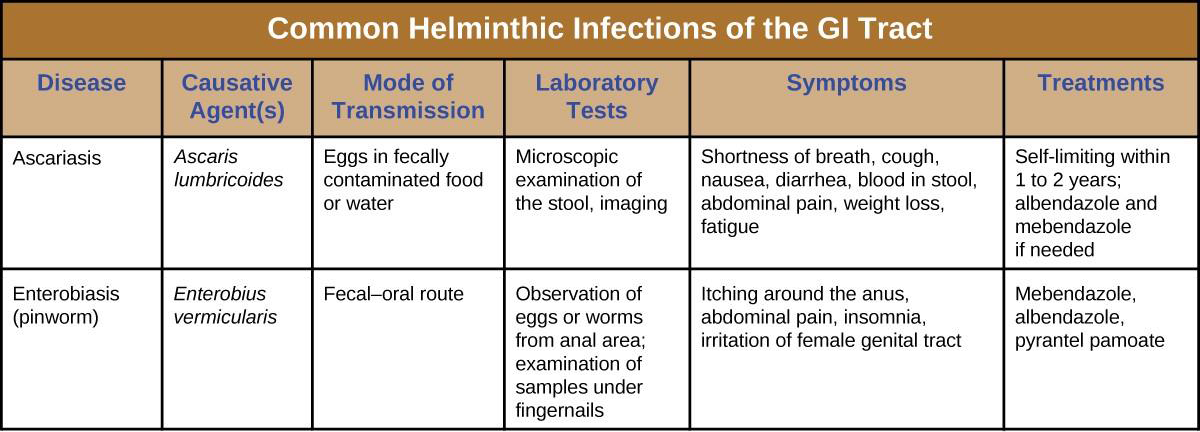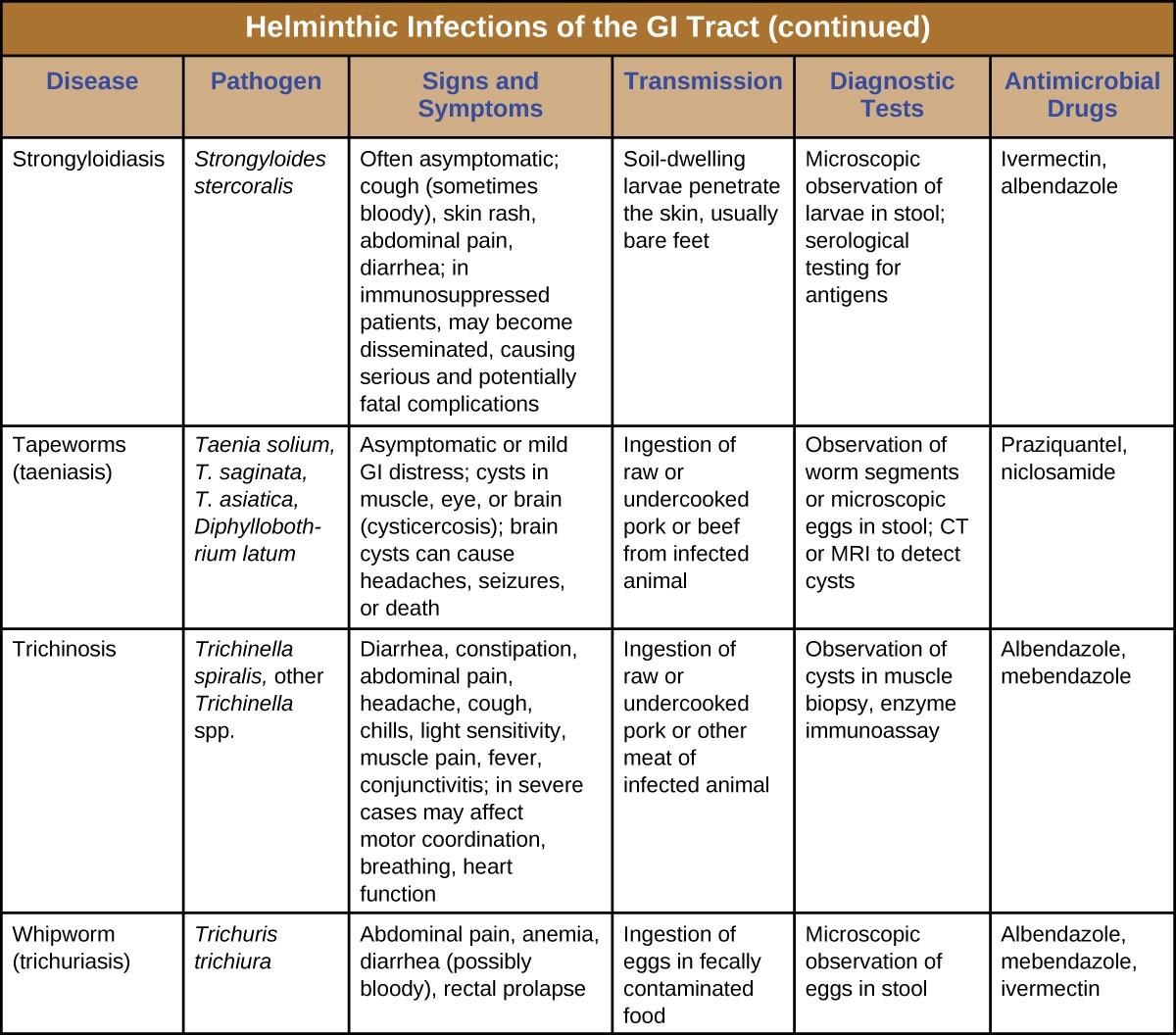19.6 Helminthic Infections of the Gastrointestinal Tract
Learning Objectives
- Identify the most common helminths that cause infections of the GI tract
- Compare the major characteristics of specific helminthic diseases affecting GI tract
Helminths are widespread intestinal parasites. These parasites can be divided into three common groups: round- bodied worms also described as nematodes, flat-bodied worms that are segmented (also described as cestodes), and flat-bodied worms that are non-segmented (also described as trematodes). The nematodes include roundworms, pinworms, hookworms, and whipworms. Cestodes include beef, pork, and fish tapeworms. Trematodes are collectively called flukes and more uniquely identified with the body site where the adult flukes are located. Although infection can have serious consequences, many of these parasites are so well adapted to the human host that there is little obvious disease.
Ascariasis
Infections caused by the large nematode roundworm Ascaris lumbricoides, a soil-transmitted helminth, are called ascariasis. Over 800 million to 1 billion people are estimated to be infected worldwide.[1] Infections are most common in warmer climates and at warmer times of year. At present, infections are uncommon in the United States. The eggs of the worms are transmitted through contaminated food and water. This may happen if food is grown in contaminated soil, including when manure is used as fertilizer.
When an individual consumes embryonated eggs (those with a developing embryo), the eggs travel to the intestine and the larvae are able to hatch. Ascaris is able to produce proteases that allow for penetration and degradation of host tissue. The juvenile worms can then enter the circulatory system and migrate to the lungs where they enter the alveoli (air sacs). From here they crawl to the pharynx and then follow the gut lumen to return to the small intestine, where they mature into adult roundworms. Females in the host will produce and release eggs that leave the host via feces. In some cases, the worms can block ducts such as those of the pancreas or gallbladder.
The infection is commonly asymptomatic. When signs and symptoms are present, they include shortness of breath, cough, nausea, diarrhea, blood in the stool, abdominal pain, weight loss, and fatigue. The roundworms may be visible in the stool. In severe cases, children with substantial infections may experience intestinal blockage.
The eggs can be identified by microscopic examination of the stool (Figure 19.17). In some cases, the worms themselves may be identified if coughed up or excreted in stool. They can also sometimes be identified by X-rays, ultrasounds, or MRIs.
Ascariasis is self-limiting, but can last one to two years because the worms can inhibit the body’s inflammatory response. The first line of treatment is mebendazole or albendazole. In some severe cases, surgery may be required.

![]()
- Describe the route by which A. lumbricoides reaches the host’s intestines as an adult worm.
Pinworms (Enterobiasis)
Enterobius vermicularis, commonly called pinworms, are tiny (2–13 mm) nematodes that cause enterobiasis. Of all helminthic infections, enterobiasis is the most common in the United States, affecting as many as one-third of American children.[2] Although the signs and symptoms are generally mild, patients may experience abdominal pain and insomnia from itching of the perianal region, which frequently occurs at night when worms leave the anus to lay eggs. The itching contributes to transmission, as the disease is transmitted through the fecal-oral route. When an infected individual scratches the anal area, eggs may get under the fingernails and later be deposited near the individual’s mouth, causing reinfection, or on fomites, where they can be transferred to new hosts. After being ingested, the larvae hatch within the small intestine and then take up residence in the colon and develop into adults. From the colon, the female adult exits the body at night to lay eggs (Figure 19.18).
Infection is diagnosed in any of three ways. First, because the worms emerge at night to lay eggs, it is possible to inspect the perianal region for worms while an individual is asleep. An alternative is to use transparent tape to remove eggs from the area around the anus first thing in the morning for three days to yield eggs for microscopic examination. Finally, it may be possible to detect eggs through examination of samples from under the fingernails, where eggs may lodge due to scratching. Once diagnosis has been made, mebendazole, albendazole, and pyrantel pamoate are effective for treatment.

Disease Profile
Helminthic Gastrointestinal Infections
Numerous helminths are capable of colonizing the GI tract. Many such infections are asymptomatic, but others may cause signs and symptoms ranging from mild GI stress to severe systemic infection. Helminths have complex and unique life cycles that dictate their specific modes of transmission. Most helminthic infections can be treated with medications.


- Centers for Disease Control and Prevention. “Parasites–Ascariasis.” Updated May 24, 2016. http://www.cdc.gov/parasites/ascariasis/index.html. ↵
- “Roundworms.” University of Maryland Medical Center Medical Reference Guide. Last reviewed December 9, 2014. https://umm.edu/health/medical/altmed/condition/roundworms. ↵

